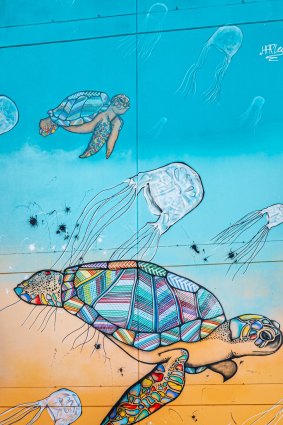This was published 3 years ago
A walking tour of Darwin unearths a story of war, disaster, and survival
By Tim Richards

***EMBARGOED FOR SUNDAY LIFE, APRIL 3/22 ISSUE*** WalkDarwin_2018_Hafleg_The_Turtle. Credit : Sebastian Kappen (handout photo, no syndication)Credit: Sebastian Kappen
As I stand at the end of Darwin's Smith Street Mall, a strange thing happens: a crocodile's huge head looms out of the footpath, its jaws open wide and its eyes an evil yellow. It's an illusion, of course, a trick of forced perspective via a clever piece of street art – the croc's head looks like a long smear of paint until you stand in just the right position.
This artistic sleight of hand will not be the last surprise of the day.
My wife Narrelle and I are about to join the Hidden Secrets of Darwin Walk, a two-hour tour which ducks and weaves through the city's CBD, unearthing art and history.
Our guide, John, starts the walk by pointing to the statue of explorer John McDouall Stuart which stands in nearby Raintree Park. A contemporary of Burke and Wills, McDouall Stuart successfully crossed Australia from the southern coast to the north and back again, establishing a route for our first international telegraph line.
Darwin was eventually founded as Palmerston in 1869, then renamed in 1911, and its development has been far from plain sailing. "Darwin has been destroyed four times in its history," John tells us. "Three times by cyclones, and once by wartime bombing."
Those disasters account partly for the CBD's very modern appearance, dotted with bland apartment buildings and office blocks. But they make up for their lack of distinctiveness with artistic opportunity, and many bear large commissioned murals.
In a back alley, West Lane, we pause at a huge multicoloured turtle swimming along a wall, painted by a local Larrakia man nicknamed Hafleg, who got his start as a tattoo artist. Nearby is a big colourful painting of the word "Milabirra", which is Larrakian for "womankind".
Passing a mural of a red kangaroo balancing atop a small grey van, we head to the courtyard of the historic Victoria Hotel. Opened in 1890, it was a haven for early aviators (including those who arrived on the first flights between the UK and Australia, which took 28 days), until it closed in 2014.
Back across the mall, we're led into the grounds of the open-air Star Cinema, which opened in 1933 and ran until 1974, when it was shut down by Cyclone Tracy. ("Its last screening was of a music festival movie, Celebration at Big Sur," John tells us.) What remains is now a pleasant shopping arcade, with one wall holding the battered tin star which sat on top of the building before being toppled by the high winds.
Moving into another alleyway, Austin Lane, we encounter more big art: a mural of woman reading a book on the wall behind the local bookshop, and a painting of celebrated musician Dr G. Yunupingu, along with lyrics from his song Baru (the Yolngu name for the saltwater crocodile).
Our tour takes a twist into retail quirkiness at the Air Raid Arcade, a 1940s shopping arcade which has somehow survived war, cyclones and modern architectural trends. Bought by bar owners in 2017, it's gradually morphed into a cool destination of hipster-friendly shops (including retailers of vintage clothing and records) and laid-back places to drink.
In contrast to the vibrant messiness of the arcade, our next stop, Darwin's surviving Chinese temple, is a serene space of reds and golds, illuminated by natural light and entered from a garden containing a bodhi tree resembling the one under which Buddha attained enlightenment. The temple is a rebuild of an original destroyed by Cyclone Tracy – an unavoidable theme in the city – and still serves as a place of worship.
Nearing the end of the walk, John starts working his local connections to provide some otherwise unattainable experiences. As we stop in Civic Park before a bust of Charles Darwin surrounded by a crescent of bells atop poles, our guide calls a contact within the adjacent city council offices. Within a minute someone has pressed the right button and the bells are chiming away for our benefit.
But his finale tops it. Leading us back into the heart of the CBD, we're taken up to the 16th floor of a shiny new office tower. We have access to what must be the best view in town: of the waterfront, Parliament House, the city parks, and the beautiful aquamarine sprawl of Darwin Harbour. It's Darwin laid out beneath our feet, a jigsaw finally assembled after visiting so many of its colourful pieces.
The writer was hosted by Walk Darwin. Its Hidden Secrets of Darwin tour costs $52 for adults, $26 for children; walkdarwin.com.au.
This article appears in Sunday Life magazine within the Sun-Herald and the Sunday Age on sale April 3. To read more from Sunday Life, visit The Sydney Morning Herald and The Age.
Sign up for the Traveller Deals newsletter
Get exclusive travel deals delivered straight to your inbox. Sign up now.